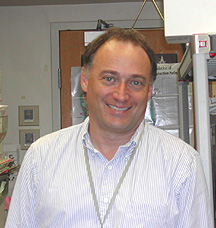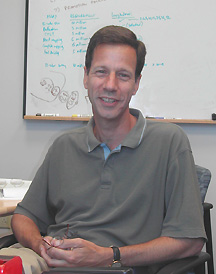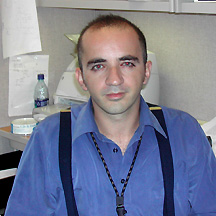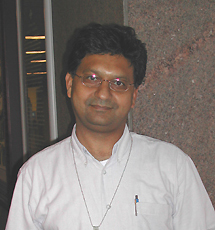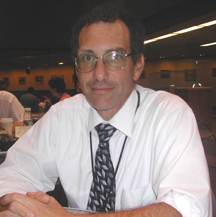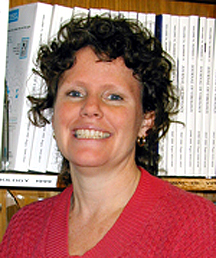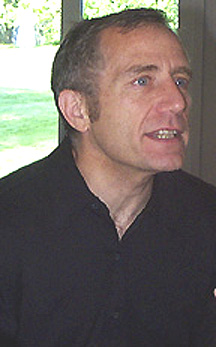INFECTION-SPECIFIC
HIV ANTIBODY ASSAY
HIV-1 Infections During Vaccine Trials: Identifying New Peptides for the Differential Diagnosis of HIV-1 Infection in the Face of Vaccine-Generated Antibodies
Hana Golding, CBER; Barney Graham, VRC
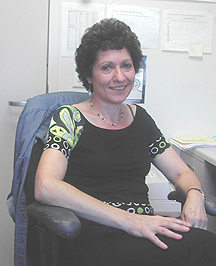 |
|
Hana
Golding
|
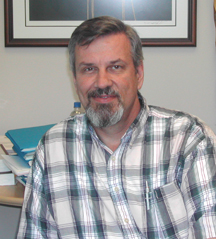 |
|
Barney
Graham
|
Within two to three years—at most—an array of HIV vaccines currently in the pipeline will be moving into large-scale Phase III clinical trials involving thousands and thousands of volunteers. The ability to distinguish vaccine-generated antibodies from actual early HIV infection among these multitudes will be imperative, says Hana Golding.
It will also be a reality.
Thanks to a Bench-to-Bedside award, Golding, chief of the Laboratory of Retrovirus Research at the Center for Biologics Evaluation and Research, FDA, and her team (postdoc Surender Khurana and fellow James Needham) have developed an alternative assay that, unlike currently licensed HIV-1 detection kits, is designed to yield a negative result in the face of vaccine-generated HIV-1 antibodies.
And on a more global level, as the numbers of trial participants balloon, false-positive test results can become a major problem for blood and plasma collection centers, as well as a source of discrimination in employment, insurance, and other facets of life.
"We have identified to our satisfaction two epitopes that will generate antibodies only in the presence of true infection," says Golding, noting that the validity of large-scale HIV vaccine trials involving high-risk participants will depend on being able to identify quickly those who get infected. The vaccine regimen would then be halted, and they would be transferred to another arm, where any effect of the vaccine could be followed and where they might be eligible for HIV therapy, according to the standard of care at the site of the trial.
Without her Bench-to-Bedside collaboration with Barney Graham, chief of the Viral Pathogenesis Laboratory and director of clinical studies at the Vaccine Research Center, NIAID, this work could not have been accomplished, she says. Further support will come from OAR, DAIDS, and NHLBI.
The Quest for Epitopes
The epitopes had to meet quite specific requirements:
![]() They could not be components of current HIV candidate vaccines, a tricky
demand because vaccine constructs have become increasingly complex as
researchers have strived to expand their immunogenicity.
They could not be components of current HIV candidate vaccines, a tricky
demand because vaccine constructs have become increasingly complex as
researchers have strived to expand their immunogenicity.
![]() They had to be epitopes that do not generate protective immunity and are
therefore dispensable in formulating new candidate vaccines.
They had to be epitopes that do not generate protective immunity and are
therefore dispensable in formulating new candidate vaccines.
![]() They had to be recognized at high enough rates during early seroconversion
to generate antibodies.
They had to be recognized at high enough rates during early seroconversion
to generate antibodies.
![]() They had to be highly conserved among many HIV variants, clades, and interclade
recombinants in order to be useful anywhere in the world a trial takes
place.
They had to be highly conserved among many HIV variants, clades, and interclade
recombinants in order to be useful anywhere in the world a trial takes
place.
To find these epitopes, Khurana constructed a gene-fragment phage-display library expressing segments from the entire open reading frame of the HIV-1 genome. The library was used to screen sera drawn from individuals within three months of initial HIV infection to establish the early repertoire of HIV-1 antibodies. Many were already components of existing HIV detection kits.
Gag-p6 and gp41 peptides met all criteria. The gp41 peptide identified is located in the cytoplasmic tail of the envelope glycoprotein and, unlike extracellular gp41, has no neutralizing epitopes. Similarly, Gag-p6, a small part of the much larger Gag-Pol protein, shows no evidence of raising neutralizing antibodies or protective cellular immunity.
"We identified these two sequences, which to our surprise had not been described in the literature as potent inducers of antibodies," Golding says. "Somehow during acute infection, enough of these portions of the proteins is exposed to the immune system to generate antibodies, and they were recognized at very high rates by samples from very early seroconverters."
Using the peptides, the team got to work producing a new immunosorbent assay that they subjected to testing with a variety of serum panels that include all known serotypes—from many countries, including Australia, Cameroon, Uganda, and the United States. Results compared favorably with currently licensed HIV-detection kits.
What’s Next
The team is now working on fine-tuning the assay, testing a second-generation of gp41 and Gag-p6 consensus peptides with even higher homology to all clades.
The assay, Golding says, is simple, rapid, and cheap, and requires no special expertise to carry out and no more than a small regular refrigerator to store the samples.
The team now has two tasks: to complete its screening of seroconverters around the world and to launch the screening of vaccinated individuals and seroconverters in HIV vaccine trials. The latter samples will come from ongoing VRC trials involving complex candidate vaccines and from already completed studies from the NIAID-funded HIV Vaccine Trials Network (HVTN).
"Here is where Barney Graham, who has been a source of advice all along, will be instrumental in the coming stages of the project and beyond the formal ending of the Bench-to-Bedside grant—in identifying and providing the best samples for us to test and to work on third-generation shorter peptides," Golding says.
For his part, Graham maintains that "this is Dr. Golding’s project—and we’re just trying to help." His role, he says, is mainly as a conduit to thousands of blood samples from the NIAID-funded HVTN.
Graham says that
for the assay to have utility, it will eventually need to be licensed
as a commercial detection kit and that its accuracy and sensitivity may
help shape the content of future candidate HIV vaccines. "When Dr.
Golding completes her testing and publishes her data, the scientific community
and vaccine manufacturers will become aware of the need to design a vaccine
to complement her assay—to avoid triggering a response detected by
the new diagnostic test," he says, noting that candidate vaccines
in VRC trials do not contain either the gp41 or Gag-p6 epitopes. ![]()
by Karen Ross
Therapeutic Targeting of a Virally Regulated Host Cell Molecule in HIV Infection
Sharon Wahl, NIDCR; Henry Masur, CC; Michael Sporn, Dartmouth; Nancy Vázquez, NIDCR
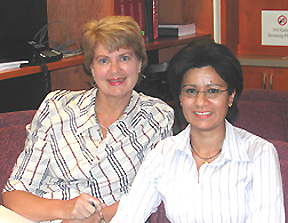 |
|
Sharon
Wahl (left) and Nancy Vázquez
|
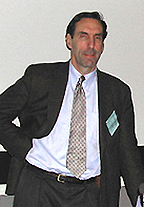 |
|
Henry
Masur
|
Despite a fire early this year that filled their lab in Building 30 with smoke and forced them to relocate for several months, Sharon Wahl, chief of the Oral Infection and Immunity Branch, NIDCR, and Senior Fellow Nancy Vázquez have made great progress on the bench side of their project.
They are interested in host cell proteins that are required for HIV infection. These proteins are excellent therapeutic drug targets, says Vázquez, because unlike viral proteins, they are unlikely to mutate and become drug resistant.
Wahl and Vázquez are focusing on macrophages as reservoirs of HIV and as targets of the virus during the later stages of AIDS when most of the CD4+ T-cells (the more famous targets of HIV) have already succumbed.
Reasoning that the levels of cellular proteins that interact with HIV would increase during infection, Wahl and Vázquez, together with colleague Teresa Wild, used a cDNA microarray to monitor changes in gene expression throughout the macrophage transcriptome during the course of infection of macrophages by HIV.
Indeed, they found two waves of increased gene expression: One occurred shortly after the initial contact of the virus with its receptor on the cell membrane; the other occurred later, after the virus had commenced replication and was accumulating inside the macrophage.
Wahl and Vázquez then focused in on one gene they considered particularly exciting because they found that preventing the spike in its expression inhibited the infection process.
Although the gene is normally involved in programmed cell death or regulation of cell division, its exact function in HIV infection is still not understood. The researchers speculate that it may promote HIV infection by aiding viral replication. They are now trying to identify other proteins, both viral and cellular, that interact with it.
Their research got an unexpectedly direct connection to the bedside through a collaboration with Michael Sporn, a former NCI lab chief now at Dartmouth College in Hanover, N.H. Sporn is interested in a class of compounds found in plants called triterpenoids that have been widely used in traditional Chinese medicine to fight inflammation and cancer. Sporn’s colleagues at Dartmouth synthesize new triterpenoid analogs, and his lab tests their properties in cell culture. He had sent one of his synthetic compounds to Wahl to use in an unrelated project. She and Vázquez decided to try the drug in the HIV-macrophage system and, to their delight, it prevented the HIV-induced increase in expression of the gene they had been studying, and it blocked infection.
Together with Henry Masur, chief of the Critical Care Medicine Department at the Clinical Center, Wahl and Vázquez are now designing a clinical trial for this drug. Because the drug also has promising anticancer activity, the team is interested in testing it in HIV patients who have lymphoma. Lymphoma, says Masur, is overrepresented in patients with HIV and has become even more prevalent in recent years as HIV patients have been living longer.
Anticancer therapy for HIV-infected patients with lymphoma needs improvement, Masur says, noting that current regimens are very toxic and interfere with antiretroviral regimens because of cross-toxicities and drug interactions.
At the moment, the Rapid Access to Intervention Development (RAID) program at NCI is working on scaling up production of the drug, and more in vitro studies are planned. Phase I trials in humans will be conducted first in patients who have lymphoma only. If the drug appears to be effective against lymphoma, the trial will be expanded to include patients with HIV and lymphoma.
Wahl, Vázquez,
and Masur all applaud the Bench-to-Bedside Award program for bringing
together basic and clinical researchers and stimulating interdisciplinary
and cross-institute research—and for providing funding for new initiatives
that might otherwise not have been able to get going. "We hope it
will be expanded," Masur says. ![]()
Use of 5-Fluorouracil (5-FU) in Combination with Antiretroviral Drugs as a Salvage Strategy to Overcome Drug Resistance in Heavily Treated HIV-Infected Pediatric Patients
Lauren Wood, NCI; Chad Womack, VRC
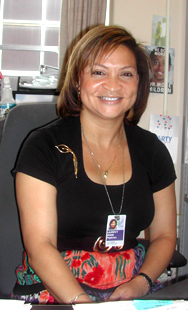 |
|
Lauren
Wood
|
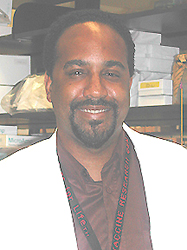 |
|
Chad
Womack
|
As a result of advances in treatment, perinatal HIV infection is now a rare event in the United States, and pediatric HIV/AIDS is now a chronic disease, observes Lauren Wood, who over the past 12 years at NCI has watched her HIV-positive patients move from childhood to adolescence and on to young adulthood, the beneficiaries of ever-improving antiretroviral strategies.
The problem now is drug resistance. Some of Wood’s "babies"—"now driving, graduating from high school, and getting tattoos"—are also starting to fail on highly active antiretroviral therapy (HAART).
"We need salvage regimens that will stave off progression to AIDS, invasive opportunistic infections, or death," says Wood, of the HIV & AIDS Malignancy Branch, NCI, and co-director of the NCI Pediatric Outpatient Clinic. She thinks the anticancer agent 5-fluorouracil (5-FU) may augment the effectiveness of certain HAART regimens and, pending bench data in the making, is designing a clinical protocol to demonstrate proof of principle.
Chad Womack, a senior research fellow at the VRC and the bench partner in this Bench-to-Bedside project, has been studying the resistance patterns in clinical isolates from Wood’s patients—who are on a variety of antiretro-viral agents—and measuring the effects of 5-FU in vitro.
The virus mutates rapidly, quickly developing resistance to the antiviral drugs it encounters, but that ability to mutate and survive in an antiviral drug environment, Womack says, may come at a price—a compromised ability to replicate.
The virus, he says, is "dancing on the edge of chaos," balancing survival through mutation against extinction through loss of replication capacity or fitness.
There is reason to believe that 5-FU will throw the virus over the edge, the researchers say.
Traditionally used as an anticancer drug, 5-FU is at the benign end of the toxicity spectrum of such agents, Wood says. As an anti-HIV agent, "it appears to alter the availability of the genetic building blocks" the virus uses to make more of itself.
Specifically, 5-FU inhibits thymidylate synthetase, an enzyme that generates thymine nucleotides, natural building blocks that HIV requires for replication. Wood nots that there are data suggesting that 5-FU can improve the intra-cellular pharmacokinetics of two of the nucleoside analogs commonly used in HAART regimens—AZT (zidovudine) and d4T (stavudine). By lowering levels of natural building blocks, 5-FU causes a preferential incorporation of defective building blocks supplied by the phosphorylation of drugs like AZT and d4T.
Womack believes it may also push the virus to hypermutate and severely cripple the virus’ replication machinery. "It’s a strategy called lethal mutagenesis, and there are other in vitro data suggesting it can be successful against HIV," he says.
Thus, the antiretroviral activity of AZT and d4T is optimized at the intracellular level without incurring the increased systemic toxicity caused by higher drug dosages, Wood notes. This point is critical, Womack adds, because many HIV-infected patients who are experiencing therapeutic failure are running out of options.
The clinical study will look at low-dose 5-FU in combination with a HAART regimen that includes either AZT or d4T in heavily treatment-experienced adolescents and preadolescents, most of whom were born with HIV, have been on therapy for 10 to 12 years, have undergone several rounds of HAART, and are failing clinically, immunologically, and/or virologically. The target enrollment is 30 patients and is anticipated to begin early next year.
A basic scientific question, says Wood, is whether virus grown out from different cellular compartments in the same individual displays a uniform resistance profile.
"We’re
looking at plasma, peripheral blood mononuclear cells, CD4 cells and subsets
including naïve and memory cells, and monocytes/macrophages. We need
to know what’s happening to the virus in these different compartments
as we give these drug combinations—that’s why these preclinical
bench studies are so critical." ![]()
